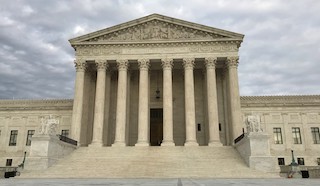On March 25, 2021, the U.S. Supreme Court decided Roxanne Torres v. Janice Madrid, et al. (2021) 592 U.S. ____, a federal civil rights (28 U.S.C. § 1983) case alleging that two Albuquerque, New Mexico police officers used excessive force and conspired to use excessive force when they shot and injured her in the back as they tried to stop her from continuing to drive.
The Gist of this Article: When police shoot at a suspect with the intent to restrain that suspect, there is a seizure and thereafter, the Fourth Amendment applies to suppression of evidence gathered without a warrant.
Ms. Torres, who was high on methamphetamine at the time, pled no contest to aggravated fleeing from a law enforcement officer, assault on a police officer and unlawfully taking a motor vehicle.
The factual background is helpful toward appreciating the Supreme Court’s ultimate ruling. Four police officers (one was named Janice Madrid (defendant)) went to an apartment complex to serve an arrest warrant on Ms. Torres, who was accused of committing certain white-collar crimes, but was also suspected of participating in drug trafficking, murder and other violent crimes.
Police found Madrid standing next to her Toyota FJ Cruiser and attempted to talk to her as she was entering the driver’s seat. According to Torres, she thought the police were trying to carjack her to steal her car, so she quickly got in her car and drove away and escaped. According to Torres, all she saw was that the officers had guns. The officers, however, were wearing tactical vests marked with the words “Police.”
Police then followed her, shooting at her car 13 times. Two of the bullets hit Madrid in her back, temporarily paralyzing her left arm, but she continued driving, eventually stopping at a hospital in Grants, New Mexico, 75 miles away, only to be airlifted back to a hospital in Albuquerque, where police arrested her.
 U.S. Supreme Court
U.S. Supreme Court
While Torres entered a plea to a criminal complaint, she also sued the officers for excessive force under the Fourth Amendment at 28 U.S.C. § 1983 in federal court. The civil case was dismissed by summary judgment for the officers at the U.S. District Court and Torres appealed to the Tenth Circuit, which affirmed the district court ruling that Torres’ Fourth Amendment excessive force claim was negated by her continued flight from the officers.
Torres then filed a petition for a writ of certiorari to the U.S. Supreme Court, which reversed the Tenth Circuit to a large degree.
The Supreme Court framed the analysis from the Fourth Amendment and held that a seizure does indeed take place when law enforcement applies physical force to the body of a defendant, even if the force does not submit and the suspect is not subdued. The Court cited to California v. Hodari D. (1991) 499 U.S. 621, 111 S. Ct. 1547, 113 L. Ed. 2d 1690 for its holding that the application of physical force to the body of a person with the intent to restrain is an arrest, not an attempted arrest, even if the person does not yield.
The Supreme Court explained that their analysis in the Torres case does not change because the force applied by Officer Madrid and her partner was applied from a distance and by shooting a gun. The important thing was that the bullet hit Ms. Torres, making the officer’s attempt to restrain Torres a seizure and made it no differently, legally, than the “end of a finger” (we should add, as long as that end of the finger is intended to restrain).
This is because, the Court explained, the focus under the Fourth Amendment is “the privacy and security of individuals,” not the particular form of the governmental intrusion. Camara v. Municipal Court of the City and County of San Francisco (1967) 387 U.S. 523, 528. The appropriate inquiry is whether the challenged conduct objectively manifests an intent to restrain. Michigan v. Chesternut (1988) 486 U.S. 567, 574.
The U.S. Supreme Court did not then proceed to evaluate the reasonableness of the attempt to restrain or the damages suffered by Ms. Torres.
We present this summary not because we regularly have cases involving police shooting at fleeing clients, but because this case nicely explains the really rather low show of governmental action for a seizure to take place and then, a motion to suppress evidence. While this case is significant from a 28 U.S.C. § 1983 perspective, we think it is more significant from a Penal Code § 1538.5 motion to suppress standpoint.
The citation for the U.S. Supreme Court ruling discussed above is Roxanne Torres v. Janice Madrid, et al. (2021) 592 U.S. ___.
For more information about what is a seizure or detention under the Fourth Amendment, please click on the following articles:
 U.S. Supreme Court
U.S. Supreme Court